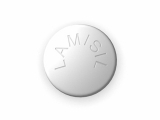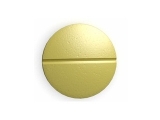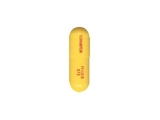Amoxicillin clavulanate 875-125
Amoxicillin Clavulanate 875-125 is a combination antibiotic drug used to treat a variety of bacterial infections. This medication is a combination of amoxicillin, a penicillin-type antibiotic, and clavulanate potassium, a beta-lactamase inhibitor that helps prevent certain bacteria from becoming resistant to amoxicillin.
Amoxicillin Clavulanate 875-125 is commonly prescribed to treat infections such as sinusitis, pneumonia, urinary tract infections, skin infections, and infections of the ears, nose, and throat. The drug works by stopping the growth of bacteria and killing off existing bacteria in the body.
It’s important to note that Amoxicillin Clavulanate 875-125 should only be taken under the guidance of a healthcare professional. It may not be safe for everyone, and it can interact with other medications and health conditions. Your doctor can help determine whether or not this medication is the right choice for your infection.
If you’re prescribed Amoxicillin Clavulanate 875-125, be sure to take it as directed and finish the entire course of treatment. Stopping medication too soon can lead to antibiotic resistance, making it more difficult to treat infections in the future.
Discovering Amoxicillin Clavulanate 875-125
What is Amoxicillin Clavulanate 875-125?
Amoxicillin Clavulanate 875-125 is a combination of two antibiotics, amoxicillin and clavulanic acid, which work together to treat bacterial infections. Amoxicillin is a penicillin antibiotic that stops the growth of bacteria, while clavulanic acid helps to prevent the breakdown of amoxicillin by certain bacteria.
What is it used for?
Amoxicillin Clavulanate 875-125 is commonly prescribed for respiratory infections, such as sinusitis, bronchitis, and pneumonia, as well as skin and urinary tract infections. It may also be used in dental procedures as a prophylactic treatment to prevent bacterial infections.
How is it taken?
Amoxicillin Clavulanate 875-125 is typically taken orally, with or without food, every 12 hours for 7-14 days, depending on the severity of the infection. It is important to complete the full course of treatment, even if symptoms disappear, to ensure that the infection is fully cured and to prevent antibiotic resistance.
Note: This medication should only be taken under the guidance of a healthcare professional and should not be shared with others.
What are the side effects?
Like all medications, Amoxicillin Clavulanate 875-125 can cause side effects. Common side effects include diarrhea, nausea, vomiting, and headaches. Rare but serious side effects may include liver damage, allergic reactions, and seizures. If you experience any serious side effects, seek medical attention immediately.
Note: If you have a history of allergies to antibiotics or are currently taking other medications, be sure to inform your healthcare provider before taking Amoxicillin Clavulanate 875-125.
Conclusion
Amoxicillin Clavulanate 875-125 is a commonly prescribed antibiotic used to treat a variety of bacterial infections. It is important to take the medication as prescribed and to contact a healthcare professional if any serious side effects occur. Always consult with your doctor or pharmacist before taking any medication.
The Basics
What is Amoxicillin Clavulanate 875-125?
Amoxicillin Clavulanate 875-125 is an antibiotic medication that contains two active ingredients, amoxicillin and clavulanate potassium. This drug is used to treat bacterial infections in various parts of the body, including the respiratory tract, skin, urinary tract, and ear infections. The combination of amoxicillin and clavulanate potassium helps to increase the effectiveness of the medication by preventing bacteria from developing resistance to it.
How does it work?
Amoxicillin works by preventing bacteria from forming cell walls, causing them to die. Clavulanate potassium works by inhibiting the production of an enzyme called beta-lactamase, which is produced by some bacteria to protect themselves from antibiotics. By inhibiting beta-lactamase, clavulanate potassium allows amoxicillin to work more effectively against bacteria.
How is it taken?
Amoxicillin Clavulanate 875-125 is typically taken orally, with or without food. The medication should be taken at evenly spaced intervals to maintain a consistent level in the bloodstream. The dosage and duration of treatment will depend on the type and severity of the infection being treated. It is important to follow the prescribed dosage and finish the entire course of treatment, even if symptoms improve before the medication is finished.
In conclusion, Amoxicillin Clavulanate 875-125 is an effective antibiotic medication that is used to treat a variety of bacterial infections. By combining amoxicillin and clavulanate potassium, this medication is able to treat infections more effectively and prevent bacteria from developing resistance to it. It is important to follow the prescribed dosage and finish the entire course of treatment to ensure the medication works properly.
Benefits and Uses
Treating Bacterial Infections
The primary use of Amoxicillin Clavulanate 875-125 is for the treatment of bacterial infections. This drug combination is effective against a broad range of bacteria, including those that cause respiratory infections, skin infections, and urinary tract infections. The addition of clavulanate to amoxicillin enhances its activity against certain types of bacteria that have developed resistance to other antibiotics.
Preventing Antibiotic Resistance
By combining amoxicillin with clavulanate, this drug helps prevent antibiotic resistance. Some bacteria can develop resistance to certain antibiotics over time, making those drugs less effective in the future. However, clavulanate inhibits enzymes produced by some bacteria that can break down amoxicillin, preserving the drug's effectiveness and preventing the development of antibiotic resistance.
Other Uses:
- Dental procedures: Amoxicillin Clavulanate 875-125 is often prescribed to prevent infection following dental procedures, such as extractions or root canals.
- Ear infections: This drug combination is also effective in treating ear infections caused by bacteria.
- Skin infections: Amoxicillin Clavulanate 875-125 is sometimes used to treat skin infections, such as cellulitis, that are caused by bacteria.
Amoxicillin Clavulanate 875-125 is often used as a first-line treatment for bacterial infections because of its effectiveness and relatively low risk of side effects when compared to other antibiotics. However, it is important to follow the prescribing physician's orders and take the medication as directed. If symptoms do not improve or get worse, medical attention should be sought immediately.
How it Works
Amoxicillin
Amoxicillin is a penicillin-type antibiotic that works by stopping the growth of bacteria. It does this by interfering with the cell walls of the bacteria, causing them to weaken and burst. This ultimately leads to the death of the bacteria.
Amoxicillin is effective against a wide range of bacteria, including Streptococcus pneumoniae, Haemophilus influenzae, and Escherichia coli. However, it is not effective against viruses, such as the flu or common cold.
Clavulanate
Clavulanate is a beta-lactamase inhibitor that works by blocking enzymes produced by bacteria that can break down and inactivate antibiotics like amoxicillin. By doing this, clavulanate enhances the effectiveness of amoxicillin, making it more potent against bacteria that would otherwise be resistant to it.
Together, amoxicillin and clavulanate work to stop the growth of bacteria and eliminate infections. This combination antibiotic is often used to treat bacterial infections of the respiratory tract, sinusitis, urinary tract infections, skin infections, and more.
- Amoxicillin stops the growth of bacteria by interfering with their cell walls.
- Clavulanate enhances the effectiveness of amoxicillin by blocking enzymes produced by bacteria that can break it down.
- The combination of amoxicillin and clavulanate is effective against a wide range of bacteria and is used to treat many different types of infections.
Dosage Information
Adult Dosage
The typical adult dosage for Amoxicillin Clavulanate 875-125 is one tablet taken twice a day, every 12 hours. This dosage may vary depending on the severity of the infection and the patient’s medical history. It is important to take the medication as prescribed by the physician.
If a dosage is missed, it should be taken as soon as possible. However, if it is almost time for the next dose, the missed dose should be skipped and the regular dosing schedule should be resumed.
Pediatric Dosage
The pediatric dosage of Amoxicillin Clavulanate 875-125 is determined based on the child's age, weight, and medical history. The physician will prescribe the appropriate dosage for the child. It is important to follow the physician’s instructions and to administer the medication at the recommended time intervals.
For infants under 3 months, the safety and efficacy of Amoxicillin Clavulanate 875-125 have not been established.
Elderly Dosage
Elderly patients may require a lower dosage due to their decreased renal function. The physician will adjust the dosage accordingly to prevent any adverse effects. It is important to follow the physician’s instructions and to monitor for any side effects.
| Indication | Dosage and Duration |
|---|---|
| Community-Acquired Pneumonia | 1 tablet twice daily for 7-10 days |
| Acute Bacterial Sinusitis | 1 tablet twice daily for 5-7 days |
| Acute Otitis Media | 1 tablet twice daily for 5-7 days |
| Skin and Skin Structure Infections | 1 tablet twice daily for 7-14 days |
- Do not crush or chew the tablets.
- Take Amoxicillin Clavulanate 875-125 with food to minimize stomach upset.
- Drink plenty of fluids while taking this medication.
- Consult a physician if any adverse effects are experienced.
Possible Side Effects
Common Side Effects
Amoxicillin Clavulanate 875-125 can cause some common side effects, including:
- Diarrhea
- Nausea
- Vomiting
- Stomach pain
If these side effects become severe or persistent, you should contact your doctor.
Less Common Side Effects
Some less common side effects of Amoxicillin Clavulanate 875-125 may include:
- Rash or hives
- Swelling of the face, lips, tongue or throat
- Breathing difficulties
- Jaundice (yellowing of the skin or eyes)
- Dark urine
- Easy bruising or bleeding
These side effects are not as common, but they can be serious. If you experience any of these symptoms, stop taking Amoxicillin Clavulanate 875-125 immediately and contact your doctor.
Allergic Reaction
In rare cases, Amoxicillin Clavulanate 875-125 can cause an allergic reaction. This can be life-threatening and requires immediate medical attention. Symptoms of an allergic reaction may include:
- Hives or rash
- Difficulty breathing
- Swelling of the face, lips, tongue, or throat
- Rapid heartbeat
- Fainting
- Seizures
If you experience any of these symptoms after taking Amoxicillin Clavulanate 875-125, seek emergency medical attention right away.
Other Considerations
While the above side effects are possible, not everyone taking Amoxicillin Clavulanate 875-125 will experience them. If you have concerns or questions about the medication, talk to your doctor or pharmacist.
It is also important to note that taking the medication with food can help reduce the likelihood of experiencing stomach-related side effects.
Precautions and Warnings
Allergies
If you have a known allergy to penicillins, cephalosporins, or any of the ingredients in amoxicillin clavulanate 875-125, do not take this medication. An allergic reaction to the medication can cause rash, itching, swelling, difficulty breathing, and anaphylaxis.
Kidney and Liver Problems
If you have kidney or liver problems, use amoxicillin clavulanate 875-125 with caution. The medication can be eliminated from the body through the kidneys and liver, so any impairment may result in longer exposure to the medication. Your doctor may need to adjust your dose or monitor you more closely.
Pregnancy and Breastfeeding
If you are pregnant or breastfeeding, talk to your doctor before taking amoxicillin clavulanate 875-125. The medication can pass into breast milk and potentially harm a nursing baby. It is best to avoid the medication while pregnant, especially during the first trimester.
Antibiotic Resistance
Taking amoxicillin clavulanate 875-125 too frequently or for an extended period of time can lead to antibiotic resistance. This means that bacteria become resistant to the medication and it may not work as well in the future. It is important to only take the medication as prescribed and not save it for future use.
Other Medications
Inform your doctor of any other medications you are taking, including over-the-counter medications, supplements, and herbal remedies. Certain medications, such as probenecid and allopurinol, can interact with amoxicillin clavulanate 875-125 and may require dosage adjustments.
Side Effects
Common side effects of amoxicillin clavulanate 875-125 include diarrhea, nausea, vomiting, and skin rash. If you experience any severe side effects, such as difficulty breathing, severe allergic reaction, or liver problems, seek medical attention immediately.
Follow us on Twitter @Pharmaceuticals #Pharmacy
Subscribe on YouTube @PharmaceuticalsYouTube





Be the first to comment on "Amoxicillin clavulanate 875-125"